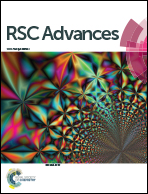Efficient conversion of acetate into phloroglucinol by recombinant Escherichia coli
Abstract
Phloroglucinol, an important fine chemical, was attempted to be produced by a recombinant Escherichia coli, using acetate, a less costly feedstock, as a alternative carbon source. Phloroglucinol was significantly produced by assembling an acetate assimilation pathway and phloroglucinol biosynthetic pathway in an engineered Escherichia coli strain. Subsequently, the culture conditions were optimized to enhance phloroglucinol production with a maximum titer of 554 mg L−1. Finally, fed-batch fermentation of phloroglucinol was evaluated using the optimized culture conditions, and reached a maximum concentration of 1.20 g L−1. The productivity (0.74 g per g DCW) and yield (0.18 g per g acetate) increased by 3.20-fold and 1.64-fold, respectively, compared with the data using glucose as the carbon source. Therefore, the engineered E. coli cells can be directly emplored for phloroglucinol biosynthesis from acetate with better atom economy and lower cost.



 Please wait while we load your content...
Please wait while we load your content...